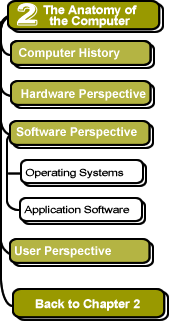

|
Operating Systems
During the 1960s and 1970s, computers became more complex, containing more hardware components and executing increasingly complex software programs. Thus, a new kind of software program evolved to "direct traffic"—that is, to help manage the computer's hardware components and software programs: the computer's operating system (or "OS", pronounced either as "oh-ESS" or to rhyme with boss).
One of the main functions of the operating system is to manage the execution of other software programs.
For example, with Microsoft Windows operating systems, one uses a graphical interface, where double-clicking the mouse over certain icons instructs the operating system to execute the corresponding program. In UNIX and MS-DOS operating systems, one types the name of a program to instruct the operating system to execute it. The operating system executes a program by first loading the bits for that program from the hard drive into the main memory of the computer. The OS then turns the program over to the CPU, letting the program instructions flow into the CPU from memory.
Because the operating system is the software program that serves as the foundation of the computer system, the operating system must get itself running as soon as the computer is turned on. This self-start of the operating system is called "booting"—from the idea of "pulling oneself up by one's own bootstraps."
Advanced: Booting the Operating System; How does the OS load itself?
![]()
![]()
These pages were written by Steven H. VanderLeest and Jeffrey Nyhoff and edited by Nancy Zylstra
©2005 Calvin University (formerly Calvin College), All Rights Reserved
If you encounter technical errors, contact computing@calvin.edu.